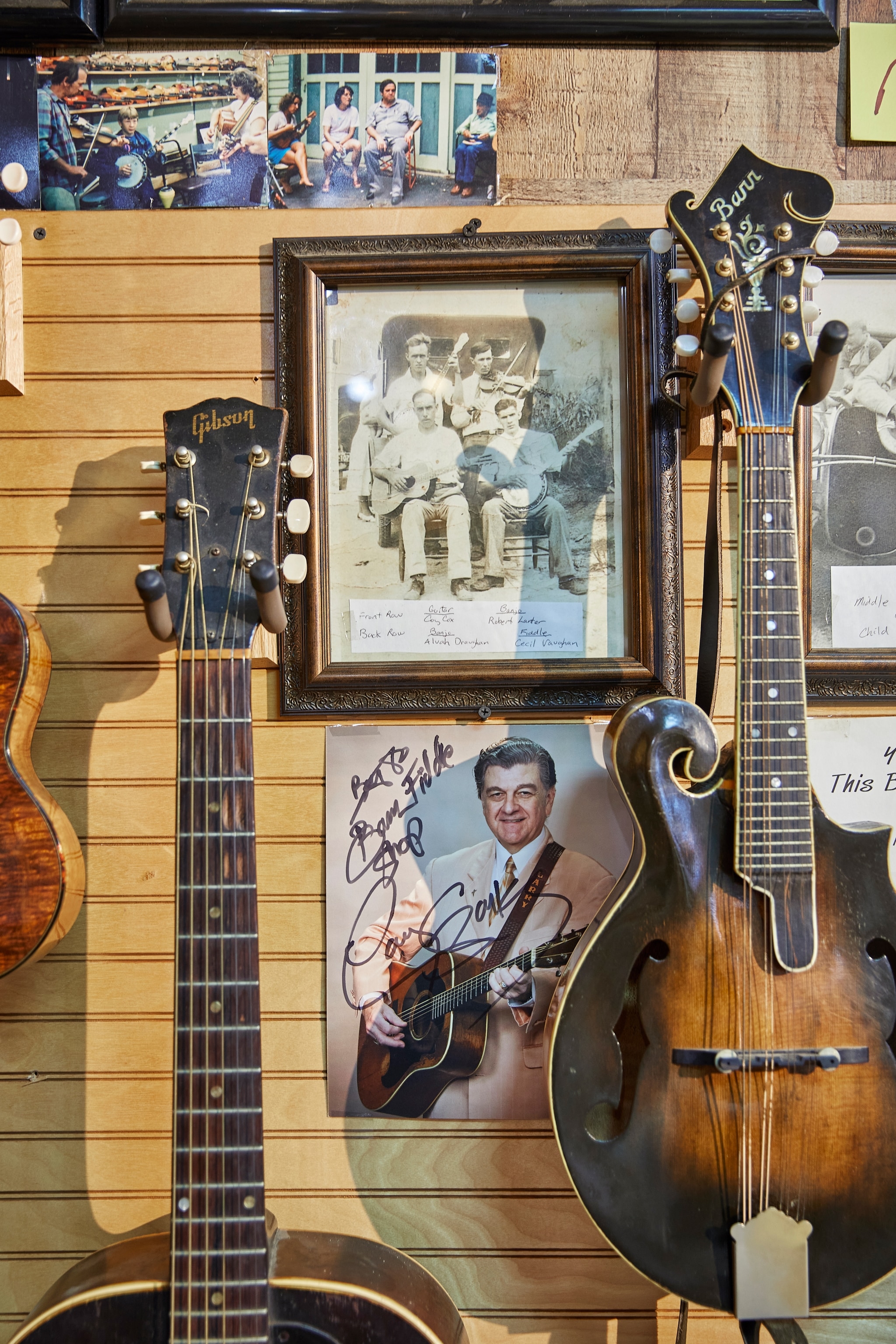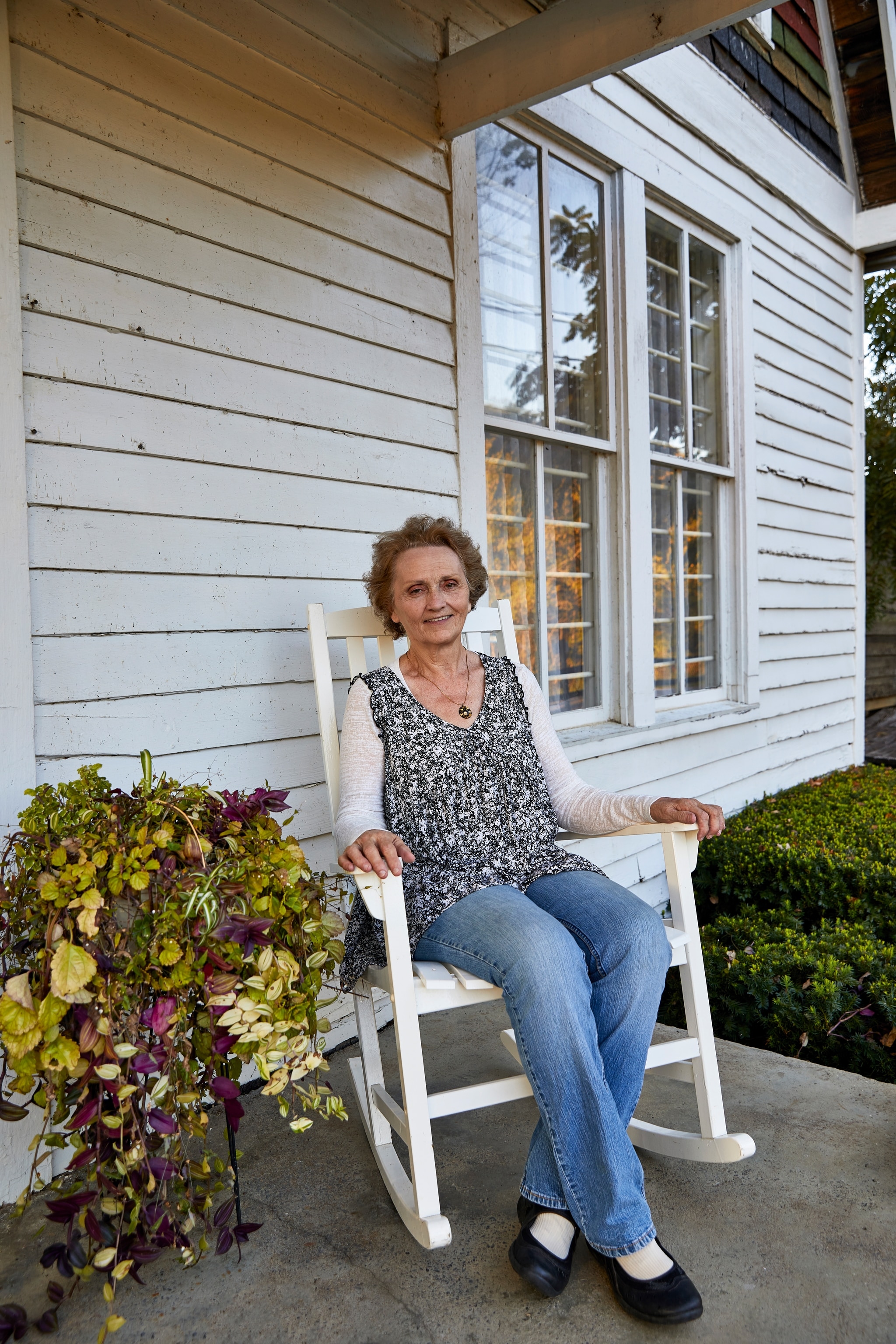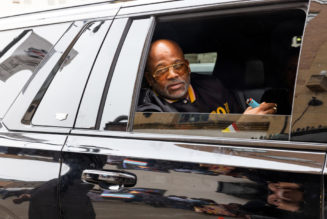This article was produced by National Geographic Traveller (UK).
The spotlights begin to fade on a stage in Floyd, not far from the misty Blue Ridge Mountains in southwest Virginia, and a banjo begins to play. Gradually, the strings pick out the notes to an Appalachian melody that’s at least a century old. Hearing it feels like unearthing a time capsule. Its composer is long gone and nobody in the audience quite knows the tune, but it doesn’t matter — soon the floor of The Floyd Country Store floods with a motley collection of country music lovers: square dancers who shuffle, cloggers that step in time with the rhythm.
Everything is in motion, and as the hour grows late, an acoustic guitar, fretted dulcimer, fiddle and mandolin join in, their players’ dexterous fingers ablur as they work the strings. In the foreground, the scenes unfolding on the dance floor are a blend of old-fashioned folk tradition and high-school dance. It’s dangerous territory for those with two left feet, like me.
In this hilly region of moonshine, waterfalls and country roads that promise to take you home, music is never far away. A mix of gospel, bluegrass and country blues, the genre of the region summons to mind duelling banjos on porches, barn-house jams and bewitching alpine landscapes.
Practically everyone here is musically gifted; I can sense that much after my first night on The Crooked Road, the state’s heritage music trail, which runs for over 330 miles through the mountains of southwest Virginia and links over 60 music venues in a web-like sprawl.
I’m here to celebrate the trail’s 20th birthday by driving part of it, starting in the post-industrial lumber town of Floyd, an hour’s drive south west of the gateway city of Roanoke, and finishing three days later in Bristol, the birthplace of country music, as designated by US Congress. For the past two decades, this lyrical nook of Virginia has drawn in lovers of the genre from far and wide.
Floyd’s musical renaissance began when Heather Krantz and her partner Dylan Locke took over The Floyd Country Store, which dates back at least as far as 1910 and has a stage tucked at the back next to shelves stocked with pie dishes and rolling pins. There’s now music and dancing held here weekly as part of the Friday Night Jamboree, as well as mountain music jams and old-time dances on weekends.
There were many reasons why Heather and Dylan decided to take over — to sustain their love of traditional music, to help promote the area’s Appalachian heritage, to open a music school and record store. “Music is our North Star,” says Heather, running a hand through her long, dark hair. “No matter where you’re from, you’re not a distant spectator at our shows — you’re part of them. The dancers hold the rhythm and become part of the music.”
It’s 10pm, and the players and dancers are spilling out from the store and onto the street. The Floyd County sheriff has his work cut out for the night dealing with the dozens of do-si-doers stepping into the traffic. A band starts the after-party in a parking lot next to the venue, and I can hear a twanging guitar and mandolin interspersed with clinking beer bottles and the clapping of the crowd that’s swaying along with the tune.

Barr’s Fiddle Shop is filled with intricately designed musical instruments made by the region’s craftspeople and artisans. Photograph by Shell Royster
Under a streetlight a few yards away, a group of a dozen players has formed a circle in a doorway and is busily preparing for a late-night session. On a bench opposite, a duo is having a jam — the rapid notes of the fiddle and the muddy acoustic guitar backing ringing out. There’s a big age gap between the two players; one is into his seventies, while the other is in his teens. “We’re constantly exchange ideas,” septuagenarian guitarist Bob Stepno tells me when he finishes playing, tugging on his fuzzy beard as we chat. The teenage fiddler, Ben Kaiser, is sitting next to him. “I’m learning from Bob and he’s learning from me,” he says, chipping in.
Southwest Virginia was at one time the end of the known world for settlers in America. Historically, the region was geographically isolated due to the thick ribbon of dense woodland around it and the barricading effect of the surrounding mountains, and today it remains a wild corner of the nation.
As I drive The Crooked Road the next day, I lose phone signal. On a sharp bend, a buck deer with a taut, muscular frame bolts out onto the road from between some oaks and just as abruptly darts away again into the wilderness. The mountain highway is leading me 50 miles south west of Floyd to the Blue Ridge Music Center, an Appalachian music museum and outdoor amphitheatre fringed on all sides by forested hills.
As I arrive, a chorus of mandolins and banjos leads me to a group of semi-retired locals taking part in a midday mountain music session. Volunteer bands started playing in the museum’s covered breezeway in the mid-2000s, their vocals joining the calls of the ever-circling red-tailed hawks out here in the wilds.
At the museum, the musical history of the area reveals itself as I wander through an exhibition of maps, songbooks and instruments. I learn that many of the Blue Ridge Mountains’ first gospel songs were written as a form of reflection on the new frontier of the mid-18th century, when migration brought hard-bitten travellers down the Great Wagon Road — the primary route for the early settlement of the South as far as South Carolina and Georgia.
Around this time, German settlers arrived, bringing with them their tradition of congregational singing, as well as the scheitholt, the predecessor to the Appalachian dulcimer, a folk instrument with metal strings. The Scots and Irish, meanwhile, arrived with religious ballads and songs, while enslaved Africans introduced banjo-like lutes such as the akonting and ngoni. These days, I’m told by programme director Richard Emmett, this is a region where musicians who are keen to keep the old music alive shake the hands of the players of yesterday. “When the fiddle met the banjo, it became the deepest foundation of all: country, bluegrass, rock ’n’ roll. It was all seeded here.” Later, country music was carried from southwest Virginia right across America.
Bristol bound
From the highland forest in its autumn coat, the road continues north for 10 miles, past barns painted jellybean-red, until it eventually reaches the outskirts of Galax. It’s mid-afternoon when I arrive, and the city of salvage workshops and antique stores is hard at work. It feels a long way from the wilds of the Blue Ridge Mountains.
Locals are wearing T-shirts with slogans like ‘Sawdust is man glitter’ and ‘Measure once, cuss twice’. Galax is home to timber yards and a flourishing furniture industry, and it’s not uncommon for wood carvers and cabinet makers here to turn their hand to stringed instruments. On one street corner, 82-year-old Tom Barr is swinging idly on a chair outside his son’s music shop. As he strums a six-string, he sings a tune for passersby, stopping to ask me to join in. “C’mon, it’s nearly the weekend,” he says with a laugh. “Let’s have a party!”
Building fretted instruments — shaping the neck of a guitar with a penknife, scraping the grain to achieve the right tone on a violin — is now big business in Galax. I’m told by Tom that the fanciest, crafted from local chestnut wood, can cost around $125,000 (£100,000) apiece.
Barr’s Fiddle Shop is a testament to the country music traditions now empowering the region’s craftspeople and artisans. I duck inside and enter what feels like a hall of fame of old-time music, where every space is cluttered with relics of the region’s musical history. Intricately designed mandolins and fiddles whittled by hand hang like pendulums; acoustic guitars bearing the Barr name stand to attention; a damaged autoharp rests in a vintage barber chair, a nod to the store’s former life. I can smell old vinyl and wood. “Come over here, I want to show you something,” says Tom, moving towards a wooden Victrola phonograph beneath a wall papered with portraits of long-gone session player friends of his. He flips its lid, carefully places the needle and slowly cranks the flat shank handle to move the turntable, talking all the while about life as an Appalachian country musician, as a sputtering ballad fills the room. “You pick up an instrument when you’re born and play ’til you die,” he says. He tells me about his father-in-law, who played the fiddle until he was 97, and the time his son played bluegrass for Queen Elizabeth II.
That evening, I finally reach the city of Bristol. The town that country music built, it was the pin-up for southwest Virginia’s musical revival, and its grid of neon-lit, red-brick buildings is full of enormous murals of 1930s-era stars such as Ernest Stoneman and Jimmie Rodgers, and half-lit honkytonks that waltz across the state line between Virginia and Tennessee on busy Main Street.

Rita Forrester is the granddaughter of the Hall of Famer Carter Family and is now the steward of the Carter Family Fold. Photograph by Shell Royster
This is where Hey, Good Lookin’ singer-songwriter Hank Williams ate his last meal in 1952, before dying of a heart attack aged 29. T Bone Burnett also found inspiration here for the soundtrack he produced for the 2000 film O Brother, Where Art Thou?. But most importantly, this is where the first ever piece of country music was put on record, during the Bristol Sessions in 1927 — and it’s this story that’s recounted at the Birthplace of Country Music Museum, on Country Music Way. Visitors come away in no doubt as to why the city proudly believes itself to be at the epicentre of what it calls country music’s ‘Big Bang’.
The breakout stars of those sessions, the Carter Family, were the first to be inducted into the Country Music Hall of Fame, a museum in Tennessee dedicated to the preservation of the genre. Throughout the Great Depression, when a quarter of America was out of work, the Bristol band still managed to ship hundreds of thousands of records, becoming one of the first stars of the country music genre. The crackled vocals of A P and Sara Carter, a husband-and-wife team, together with the unique finger-style guitar scratch of sister-in-law Maybelle, are as much a part of life along The Crooked Road as the buzz of sawmills and the pealing of church bells.
On my last night, I head off beyond Bristol in search of their family home. The sun is still up and green hills fill the windscreen as the road slowly rolls straight up to the barn doors of the Carter Family Fold, where purple dahlias skirt cattle fences and a crowd has rallied for the weekly Saturday jamboree.
Time seems to stand still here, and the stage is set as it might have been for a congregation a century ago. Church pews and an upright piano frame the stage and, as well as hymn sheets and an open Bible, there’s an altar of portraits of the tangled Carter family tree, including Grammy winner June Carter Cash and her renegade husband Johnny. Children line up for over-buttered popcorn and cream soda, in preparation for their screeching and hop-scotching across the wooden dance floor. A sign on the door reads ‘No alcohol permitted’.
Tonight’s players are a crowd favourite string band from Tennessee — Uncle Shuffelo and His Haint Hollow Hootenanny — but an equal draw is matriarch Rita Forrester, the Fold’s elderly steward, host and granddaughter of the legendary A P and Sara. When I meet her, she explains how the focus here is still firmly on idealism, family and faith. “My grandad was a stickler for good moral values,” she says, before taking her place on the rocking chair on stage. “It’s about honest, clean fun.”
Underlining the Carter code, Rita is simultaneously babysitting her granddaughter this evening — the soundcheck even features a soiled diaper — and it’s clear her role as this old-time music minister is one of duty as much as it is pleasure. She tells me how she grew up with country gospel filling every room, but saw the darker underside of the genre, too, and never planned on being the front person. “My parents split, my grandparents split, June and Johnny were always arguing,” she says. “But I promised my mom I’d do my very best to keep our music alive. If I fall short, it’d be like missing church on Sunday.”
The traditional string band arrives in their best clothes for a rollicking two-hour set. Whirring ceiling fans add an extra percussive wave and dancers rise to their feet, one by one, as if professing their faith. Once again, I find myself at the edge of a wooden dance floor filled with hot-steppers, romancing old-timers and raucous children, but this time there’s also a left-footed dancer among them who masks his mediocrity with a show of jokey handclaps and twirls.
Later, as I reluctantly turn around to leave, a loud, echoey voice rises up from behind me on the stage: “Jump in anytime you like. No one’ll notice you weren’t there from the beginning,” it says. It’s a notion in keeping with the philosophy of The Crooked Road, I think — it’s endlessly generous, and always ready to welcome newcomers with open arms. They’re not stingy with the music here — there’s enough of it to go around.
To subscribe to National Geographic Traveller (UK) magazine click here. (Available in select countries only).









